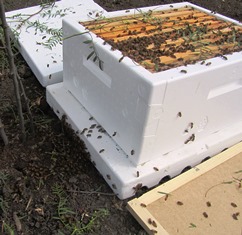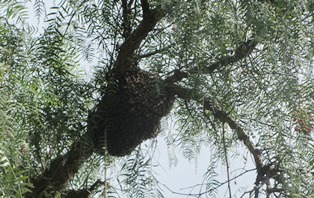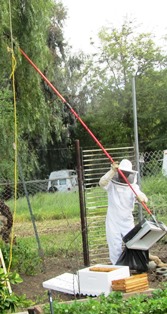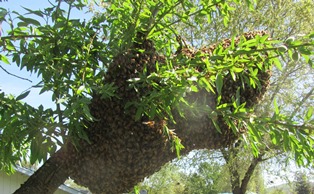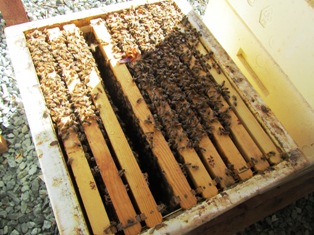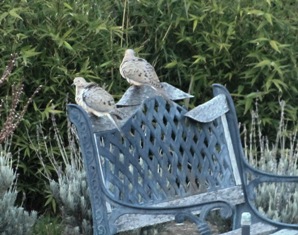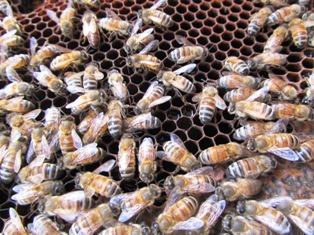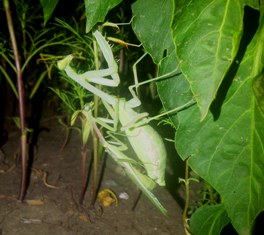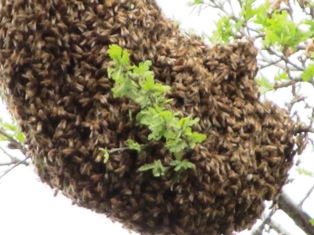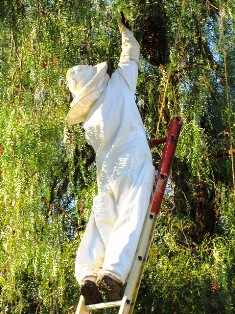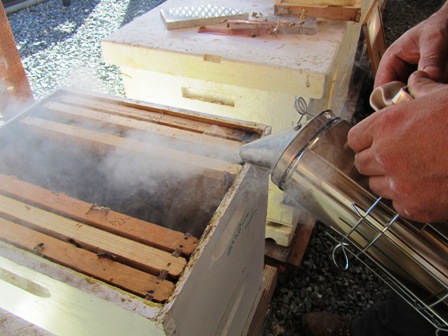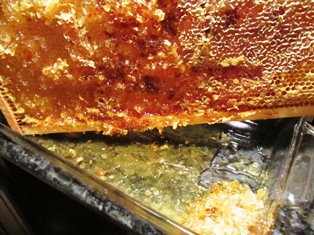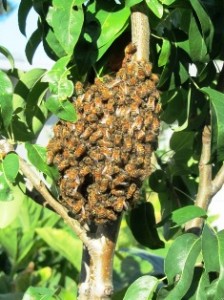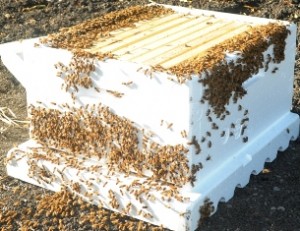Archive for the 'Insects' Category
Déjà Vu
I heard the whine even before I looked up and saw the honeybees coalescing into a swarm. I was on my knees at the back fence of the farmette helping my husband Carlos remove weeds from under the pepper tree. I dashed into the kitchen to retrieve a stainless steel pan and, using the gardening trowel still in my hand, began banging on the pan’s bottom.
My beekeeper neighbor swears that the banging noise disorients the bees so they will take refuge in a nearby tree instead of flying miles away. This was the second swarm in as many weeks on our farmette.
The swarm from my neighbor’s hive alighted in the tall pepper tree at our back fence line. Just a week or so ago, a swarm landed in our almond tree. Dressed in his beekeeper’s suit and gloves, my neighbor arrived carrying a black garbage bag fastened to an empty bee box secured with tape. He and Carlos figured they would affixed the box to a long pole–our tree limb trimmer.
Carlos volunteered to climb the tall sectional ladder and began to suit up. He would be the rope puller who would shake the limb. The rope was already there thanks to a swarm last year in the same spot.
I wondered if shaking the bees off that high limb would work. They would have to drop precisely into the box that my neighbor would be positioning under the the writhing swarm. What if the bees fell, missed the box, and flew right back up?
Well, it did work. Most of the bees landed in the garbage bag. The bag was duly shaken over the prepared hive. There, the bees stayed. Our neighbor went home to his own gardening chores, and Carlos and I resumed our weeding, albeit in a different part of the property since a few stressed-out bees were still buzzing around that tree.
Streak of Warm Weather Starts Seasonal Bee Swarms
Last Wednesday heralded the official onset of spring. And it sure felt like it around the East Bay. The local beekeepers became more watchful as increasing bee traffic predicted an increased likelihood of swarms.
Last year, we rescued more than a dozen swarms from neighborhood trees as far away as two miles. Bees will fly up to five miles in search of food (they also need water), returning to their hives before darkness and the cool night air sets in.
Swarming is the way honeybees increase their numbers. The queen lays eggs throughout the winter and in spring, the hive will need more room to accommodate all the new offspring. Beekeepers can add “extensions,” but swarms will still happen.
The first swarm of the season found its way to my almond tree on the day before Easter. I had vigorously pruned the branches two years ago after discovering some limbs badly diseased. But the tree rebounded with hundreds of small, thin branches. The weight of the massive swarm caused the branch to give way. The bee swarm fell apart.
In less than a minute, the honeybees were again huddled around their queen on a thicker, stronger branch.
A styrofoam super with frames already inserted was placed under the branch. All it took was a couple of hard shakes of the limb to knock the bees in their new home.
The lid of the super was reattached and the box positioned so that the opening (the bees’ front door) faced the tree. The swarm would find safe haven inside the super as night approached.
After dusk, the super was turned from its western-facing direction to ensure that the bees’ front door faced east, the direction of the sunrise. Bees love the light and warmth of the sun.
Around the top of the super, some of the honeybees did a tail-waggle dance. My beekeeper neighbor told me it was their way of telling the other bees that this was their new home; to, “come on in.”
I guess those little fellows doing the waggle dance were the welcoming party.
A Whole Lot of Coupling Going On
Lately, the way the birds, insects, and wild creatures are pairing up, you’d think we were on Noah’s Ark instead of the Henny Penny Farmette.
I’ve never seen such bird and bee traffic as in the last few days. This morning, I put on the bee suit and joined my neighbor on a tour of inspection to see if the bees survived the cold snap we had a week or so ago. We had snow on Mount Diablo and a hard frost elsewhere. But the bees are fine, and there are lots of babies.
Today, the yellow finches are congregating around the Nyjer feeder and singing their little hearts out. There’s a woodpecker in the neighborhood (maybe two). I haven’t seen it/them but there’s a whole lot of tap-tap-tapping in the nearby oak trees.
I often see a flash of blue as I work to move and amend the soil on our property. Last year about this time, pair of Western blue birds were scouting locations for a nest. They are back and I hope they stick around.
The plaintive coo-coo-coo of the mourning doves has become a chorus of late. At first, I noticed a pair in the back yard and now there are several pairs. They mate for life. So we’ve put out birdseed and I fully expect to see a nest or two being constructed in the next few weeks.
Birds and bees are either producing young or making preparations to produce offspring. But the praying mantises? Who knew?
So what I’m taking from all this pairing up is that Mother Nature expects warm days ahead. The wild creatures made it through the winter. No one has to tell them what to do now that spring is only weeks away. Like I said, it looks like Noah’s Ark around here.
Plants Bees Love
Last summer, I saved the seed from the flower heads plucked out of the gardens around the Henny Penny Farmette (cosmos, zinnia, marigold, nasturtium, and others). Now that the weather has turned warm (and rain is forecast next week), now might be good time to plant those seeds.
I also want to put in some other plants that bees love. People who do not like bees buzzing around can use the list as a reference for what NOT to plant.
Plant open-pollinating plants and avoid hybridized seed that does not have the high pollen content that is most beneficial to the bees. See, http://thehoneybeeconservancy.org/act-today-2/plant-a-bee-garden/
LIST OF PLANTS FOR YOUR BEE GARDEN
abelia, acacia, Arenaria verna, artimesia, aster, savocado
bee balm, buddleia
callistemon citrinius (the bottlebrush shrub), calendula, calluna, ceanothus, Choisya ternata, citrus (all kinds), clover, cosmos, cotoneaster, crataegus
echinacea, echium, erica, eriogonum, escallonia, eucalyptus
feijoa, foxglove
gleditsia
heteromeles, hosta
iceplant
ligustrum (privet), Lonicera japonica (honeysuckle), Lonicera hildebrandiana
murraya paniculata
phyla nodiflora,polygonum capitatum, pyracantha
rosmarinus officinalis (rosemary)
salvia (sage), snapdragon, sorbus aucuparia, syzgium
Teucrium chamaedrys, thyme, Trachelospermum jasminoides (star jasmine)
wild lilac, wisteria, witch hazel
zinnia
While you are busily putting into the garden the plants bees love, why not put out a saucer of water with some large rocks or pebbles for them to stand on while they are drinking? Yes, honeybees get thirsty, too.
The gardens that attract bees are often gorgeous because of all the pollinating the bees do. When you plant the flowers bees love because of high pollen content and provide water, you are not only helping your garden to flourish, you are helping the beleagured honeybees. Our planet needs them.
Bees: Upstairs, Downstairs
My neighbor’s honeybees, just like people, love the warm weather. They’ve been busily scouting out sources of pollen during this past week of springlike temperatures hovering in the upper 60s Farenheit on the Henny Penny Farmette.
I’ve put out a little pottery saucer, the size of a dinner plate, to hold a bit of water for the honeybees who are flocking to the feet of the little angel statue I placed in the center. The bees need something to stand on or they’ll drown. My beekeeper neighbor says wine bottle corks are great for giving the bees a support while they hover near the water to quench their thirst.
Bees, left undisturbed, will build a healthy and strong colony providing they have a food and water source and a a brood box or super in which to live. Of course, they could also take up residence in a hollow tree trunk or other wild place of their choosing. But supers are what beekeepers use.
As the colony grows, the bees will definitely need a super. During the summer months, adding a super on top of the brood box or other super gives the honeybees more room “upstairs.” There, they can store honey while “downstairs” the queen can lay more eggs in the cells of the brood box.
Seeing so much bee activity after a quiet winter, I’m ready to start planting annuals and perennial flowers with high pollen value that attract the bees. More food for the bees means more honey in the hive.
Keeping a Garden Ecosystem in Balance
A healthy ecosystem, whether in a forest or a garden, stays in balance in part because of its “grazers” and “predators.” The grazers can range in size from a large plant-eating animal like a cow to a tiny aphid, and predators share this size range, too. Consider for example, a tiger (predator) in a wild, natural environment dining on an antelope (a grazer) or tiny ladybug (a predator for grazing aphids) in a rose garden.
A lush, healthy garden will have an underlying healthy ecosystem. If your garden plants are being devoured by pests, you might want to introduce more of the pests’ natural enemies. For example, if your roses are infested with one or more of the 200 different types of aphids, buy lacewings.
One lacewing larva can destroy roughly 200 pests (and pest eggs) for as long as two or three weeks. The adult lacewings do not kill insects (they suck nectar and pollen), but their larvae will inject venom into aphids and then suck out the the plant grazers’ body fluids, which destroys those pests. Adult lacewings will stick around if there are sources of pollen, nectar, and honeydew. They are beneficial to a garden ecosystem because the lacewing larvae feed on spider mites, mealybugs, leafhoppers, thripes, and other unwanted plant grazers.
Take a stroll around your garden on a regular basis. Take note of its ecosystem. Create a healthy garden using organic products when possible. Remember that plants cycle through seasons. There may be periods of the year when your plants seem to be more infested than at other times. Practice tolerance if an infestation is mild. Let nature run its course. If the balance is right in your ecosystem, the predators will take care of the grazers.
Food for Bee Babies
The bee suit I’ve worn this morning smells like smoke from the smoker. My neighbor opened his hives today to check on the status of the bees and I was happy to help. I learn something new every time I work with him. We’ve had freezing nights with the temps hovering below 30 degrees Fahrenheit, not good for bees.
Upon opening the first hive, we could see the bees were docile. After all, it is winter. The bees must work hard to keep heat in the hive and they aren’t expecting us to be intruding into their world. In fact, my neighbor didn’t bother with putting on either the beekeeper suit or the elbow-length leather gloves. He loves his bees and has no fear of being stung.
Our work today was putting into each super a patty of brood building food (mainly high fructose corn syrup, soy flour, and other nutrients) as a substitute for pollen, especially necessary to feeding bees. Beekeepers often feed their bees in late winter or early spring since there is little pollen to be scavenged from flowers. Flower and blossom pollen comes later in the spring.
We must do all we can to help the beleaguered little honeybees. We have even covered their hives with blankets, reducing the necessary labor of the worker bees in keeping the hive humming and warm.
So I don’t mind smelling a little like smoke for a while to help the bees, and I’m hoping the bees won’t mind that I took one little frame of honey from their hive to my kitchen.
Beekeepers: Take Note of Your Local Regulations
Backyard beekeeping has become a hot hobby . . . and it has come at an important juncture in the history of our planet. For several years, honeybee populations have been dwindling and bees mysteriously disappearing in Europe and America. This is worrisome since the bees are necessary for pollination of crops.
Perhaps you live in a city or town that supports beekeeping and has written that support into the municipal code or state law. Count yourself lucky to have all those little honeybees to pollinate your garden–even if you aren’t the beekeeper. But if you love honey, like I love honey you’ll want your own hive.
Before you go shopping for your beekeeper suit, check out your town’s municipal code and zoning regulations that cover the keeping of bees. Also, find out what state regulations might apply. Your town might not even permit beekeeping.
California law requires beekeepers to notify their counties. Having the law on the books, however, doesn’t necessarily mean the law is rigorously enforced. Lack of funding for oversight and enforcement makes it difficult to ensure the community’s beekeepers are compliant.
You might have to spend a little time trying to decipher the language in your municipality’s documents. Cities in the San Francisco Bay Area, have ordinances and regulations governing beekeeping that differ as widely as the language (contained in their documents) used to characterize bees. Bees as livestock . . . or exotic animals. Really?
Foster City and Fremont, both south of San Francisco, but on opposite sides of the bay, ban beekeeping. Further south, the cities of Palo Alto and San Jose require permits. So do some cities north of San Francisco, including San Rafael, Sausalito, Fairfax, and Tiburon. In Concord, it is unlawful to keep hives or maintain an apiary in the city, except under certain conditions. No hive within 25 feet of the property line and a sign at the front of the property advising of the presence of bees.
If you are a honey loving, aspiring beekeeper/gardener, I hope you are in one of those towns across America that recognizes the value of these little pollenizers. The populations of these beleaguered, little creatures are dwindling as if they were under siege. When your city/county/state supports your efforts (with the honeybees, of course), everyone wins. Best of all the honeybees and the planet wins. Imagine having to pollinate the gardens and fields of the world by hand. Now that’s a sobering thought.
The Seductive Taste and Smell of Honey
The sweet, seductive scent of honey permeates the rear of my property where the honeybee traffic has picked up now that we have had a few warm days. My neighbor Peter told me on Saturday that we would open the hives today. I enjoy helping him with bees, and my organic yogurt wouldn’t taste the same without that sweet honey drizzled on top.
Peter says it’s coming on winter now and the bees need food. Sources of pollen diminish during fall and winter. Our inspection will determine whether or not the bees and their hives are in good shape. Most likely, if there is honey, we won’t harvest it but rather leave it for the bees. Still . . . if there’s an abundance, we might take a frame or two.
When he was just a boy, Peter received his training as a beekeeper from his father. His father’s honeybees kept their Lebanese village supplied with honey. Our purpose in opening the hives today is to inspect the physical structures of the hives for mold, mites, ants, or any foul smell that might suggest a problem.
We last medicated the bees during the first week of October. This morning, the bees were so docile, Peter didn’t even suit up. But I did. Even so, the last time I put on the head-to-toe bee suit and the elbow length leather gloves, I still got stung as I was removing the suit.
At approximately 9:30 a.m. , we started to open the hives, smoking each one, in turn and closely checking each frame. The hives all looked healthy and robust. We removed spent containers of Apigard and the hanging sticks of antibiotic.
After inspecting each frame in each hive, we re-medicated the bees to ward off mites and anything that might attack or weaken the immune systems of the bees. The goal is to keep them healthy and strong so that the honeybees survive with their babies through the winter to swarm in the spring (swarms are the way the bees expand their populations).
The last three hives were particularly strong. The bees were busily working. Each super (styrofoam box or hive that holds ten frames) was heavy. We reduced the sizes of the hives to two supers instead of a stack of three on top of each other. Smaller hives during the winter means less work for the bees to stay warm and make babies.
Peter handed me three frames of honey to take to my kitchen. He also took a frame or two. Tomorrow, I’ll make a honey cake . . . if I can stop myself from constantly sampling the gorgeous colored, sweet tasting honey that slowly drips from the frames into large glass dishes in my kitchen.
Protecting Honeybee Hives
In early October, I helped my beekeeper neighbor medicate his honeybees as well as the bees in the hives he had given me. Our work will ensure the bees make it through the winter. Although some beekeepers do not believe much in the value of medicating bees to ensure the health of the colony, my neighbor (who learned beekeeping at the knee of his father) maintains a healthy colony of bees that are flourishing and producing large quantities of honey.
Healthy bees are necessary for pollination of our nation’s crops. For reasons not well understood, roughly one-third of all the U.S. honeybee colonies have disappeared since 2006 when beekeepers in America and Europe sounded the alarm that worker bees were not returning to their hives and disappearing at alarming rates. Initially beekeepers and scientists postulated that the honeybee problem could be traced to infection by mites, a fungus, a weakened immune system, contact with pesticides, and/or stress or combinations of several factors. More recently, studies are suggesting that the CCD problem possibly is related to the use of neonicotinoids, a new class of pesticides introduced in the 1990s.
Chemically linked to nicotine, neonicotinoids are associated with diminishing bee populations in several new studies, although the Agriculture Research Service (ARS), the internal research agency of the U.S. Department of Agriculture, asserts that little is known about the causes of CCD. The ARS offers the following advice to beekeepers: “mitigation must be based on improving general honey bee health and habitat and countering known mortality factors by using best management practices. This includes supplemental feeding in times of nectar/pollen scarcity.” See, http://www.ars.usda.gov/News/docs.htm?docid=15572#bk
Commercial beekeepers feed their bees corn syrup and neonicotinoids have been used routinely on corn. Recently, Harvard Professor Chensheng Lu was quoted in a New Yorker article as stating he believes one reason for CCD is the “link between high-fructose corn syrup and use of neonicotinoids.”
So while my neighbor and I can medicate against pathogens and parasites, we will be watching to see what the EPA, the USDA, and other governmental agencies decide about the widespread use of pesticides and specifically the use of neonicotinoids.
 Facebook
Facebook Goodreads
Goodreads LinkedIn
LinkedIn Meera Lester
Meera Lester Twitter
Twitter





